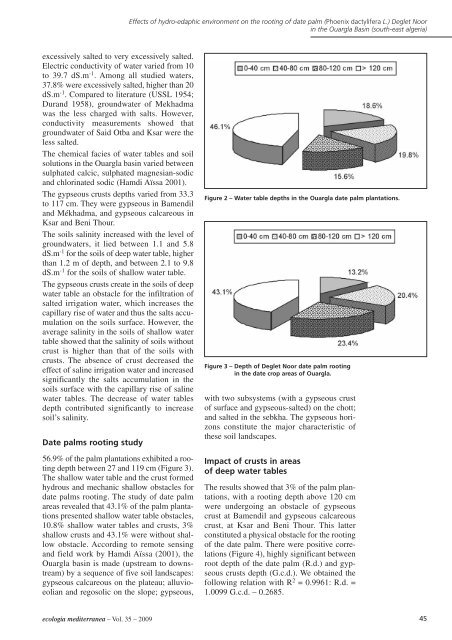Vol. 35 – 2009 - Ecologia Mediterranea - Université d'Avignon et des ...
Vol. 35 – 2009 - Ecologia Mediterranea - Université d'Avignon et des ...
Vol. 35 – 2009 - Ecologia Mediterranea - Université d'Avignon et des ...
You also want an ePaper? Increase the reach of your titles
YUMPU automatically turns print PDFs into web optimized ePapers that Google loves.
excessively salted to very excessively salted.<br />
Electric conductivity of water varied from 10<br />
to 39.7 dS.m -1 . Among all studied waters,<br />
37.8% were excessively salted, higher than 20<br />
dS.m -1 . Compared to literature (USSL 1954;<br />
Durand 1958), groundwater of Mekhadma<br />
was the less charged with salts. However,<br />
conductivity measurements showed that<br />
groundwater of Said Otba and Ksar were the<br />
less salted.<br />
The chemical facies of water tables and soil<br />
solutions in the Ouargla basin varied b<strong>et</strong>ween<br />
sulphated calcic, sulphated magnesian-sodic<br />
and chlorinated sodic (Hamdi Aïssa 2001).<br />
The gypseous crusts depths varied from 33.3<br />
to 117 cm. They were gypseous in Bamendil<br />
and Mékhadma, and gypseous calcareous in<br />
Ksar and Beni Thour.<br />
The soils salinity increased with the level of<br />
groundwaters, it lied b<strong>et</strong>ween 1.1 and 5.8<br />
dS.m -1 for the soils of deep water table, higher<br />
than 1.2 m of depth, and b<strong>et</strong>ween 2.1 to 9.8<br />
dS.m -1 for the soils of shallow water table.<br />
The gypseous crusts create in the soils of deep<br />
water table an obstacle for the infiltration of<br />
salted irrigation water, which increases the<br />
capillary rise of water and thus the salts accumulation<br />
on the soils surface. However, the<br />
average salinity in the soils of shallow water<br />
table showed that the salinity of soils without<br />
crust is higher than that of the soils with<br />
crusts. The absence of crust decreased the<br />
effect of saline irrigation water and increased<br />
significantly the salts accumulation in the<br />
soils surface with the capillary rise of saline<br />
water tables. The decrease of water tables<br />
depth contributed significantly to increase<br />
soil’s salinity.<br />
Date palms rooting study<br />
56.9% of the palm plantations exhibited a rooting<br />
depth b<strong>et</strong>ween 27 and 119 cm (Figure 3).<br />
The shallow water table and the crust formed<br />
hydrous and mechanic shallow obstacles for<br />
date palms rooting. The study of date palm<br />
areas revealed that 43.1% of the palm plantations<br />
presented shallow water table obstacles,<br />
10.8% shallow water tables and crusts, 3%<br />
shallow crusts and 43.1% were without shallow<br />
obstacle. According to remote sensing<br />
and field work by Hamdi Aïssa (2001), the<br />
Ouargla basin is made (upstream to downstream)<br />
by a sequence of five soil landscapes:<br />
gypseous calcareous on the plateau; alluvioeolian<br />
and regosolic on the slope; gypseous,<br />
ecologia mediterranea <strong>–</strong> <strong>Vol</strong>. <strong>35</strong> <strong>–</strong> <strong>2009</strong><br />
Effects of hydro-edaphic environment on the rooting of date palm (Phoenix dactylifera L.) Degl<strong>et</strong> Noor<br />
in the Ouargla Basin (south-east algeria)<br />
Figure 2 <strong>–</strong> Water table depths in the Ouargla date palm plantations.<br />
Figure 3 <strong>–</strong> Depth of Degl<strong>et</strong> Noor date palm rooting<br />
in the date crop areas of Ouargla.<br />
with two subsystems (with a gypseous crust<br />
of surface and gypseous-salted) on the chott;<br />
and salted in the sebkha. The gypseous horizons<br />
constitute the major characteristic of<br />
these soil landscapes.<br />
Impact of crusts in areas<br />
of deep water tables<br />
The results showed that 3% of the palm plantations,<br />
with a rooting depth above 120 cm<br />
were undergoing an obstacle of gypseous<br />
crust at Bamendil and gypseous calcareous<br />
crust, at Ksar and Beni Thour. This latter<br />
constituted a physical obstacle for the rooting<br />
of the date palm. There were positive correlations<br />
(Figure 4), highly significant b<strong>et</strong>ween<br />
root depth of the date palm (R.d.) and gypseous<br />
crusts depth (G.c.d.). We obtained the<br />
following relation with R 2 = 0.9961: R.d. =<br />
1.0099 G.c.d. <strong>–</strong> 0.2685.<br />
45
















